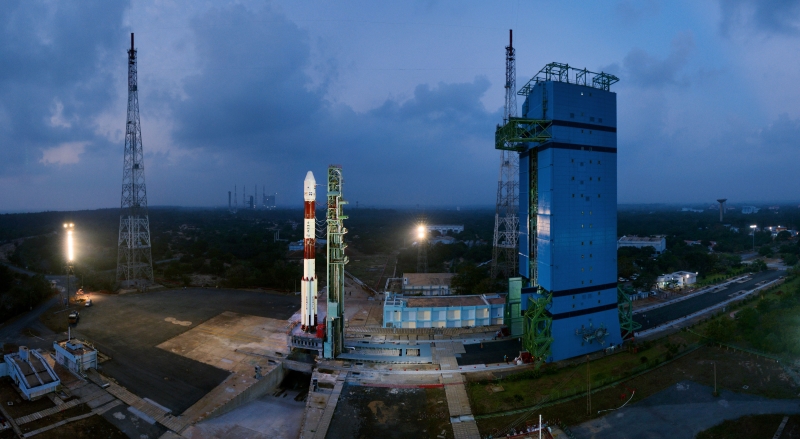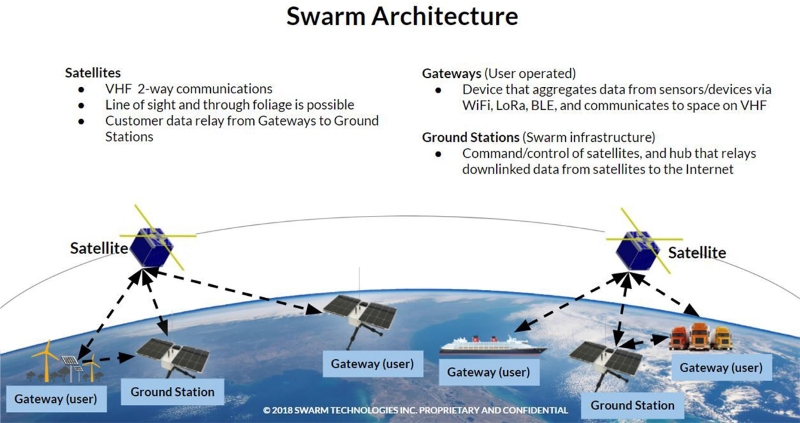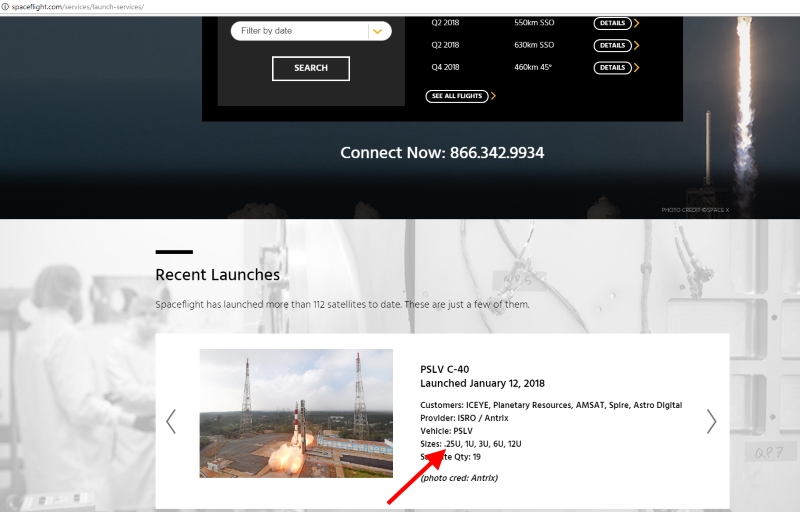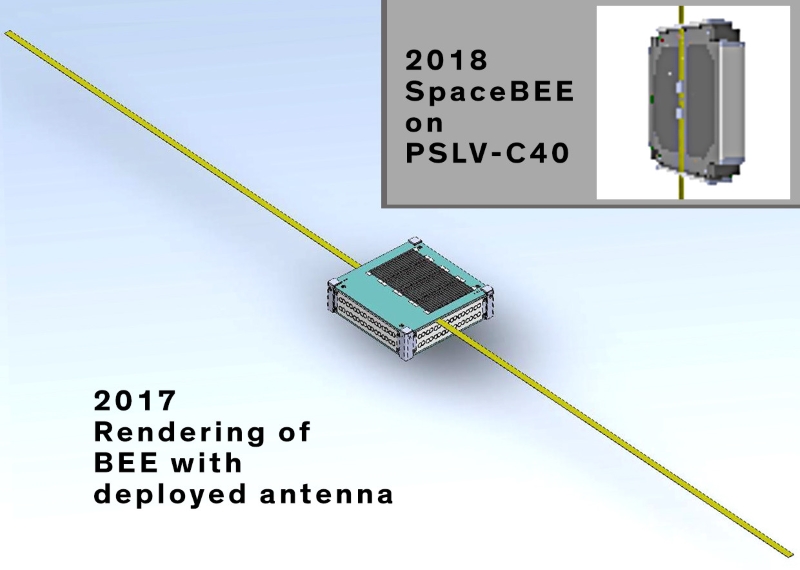Space illegal SpaceBEE
In 2018, for the first time in the history of private astronautics, commercial satellites were launched illegally. More precisely, it turned out that the American rocket satellites launched on an Indian rocket launched in January were not authorized by the Federal Communications Commission.

Booster PSLV before launch, photo ISRO
On January 12, the Indian launch vehicle PSLV was launched, the main payload of which was the Earth remote sensing satellite Cartosat-2F. Thirty American, South Korean, Indian, and other micro and nanosatellites flew in passing loads. And, according to the IEEE Spectrum portal, some of them were not worth being on this rocket. Four SpaceBEE satellites almost certainly belong to the startup Swarm Technologies from Silicon Valley, which is now operating in closed mode .

Part of the PSLV payload list, ISRO Figure
')
The problem is that on December 12, 2017, Swarm Technologies was denied a license to launch and operate their satellites, argued that they are too small to be easily monitored and, therefore, would be dangerous when they break and become space junk. At the same time, the measures taken by Swarm in order to increase the visibility of the satellites were considered insufficient.
The idea of a startup Swarm Tehnologies lies in the satellites that distribute the Internet of things. A variety of gadgets need constant access to the Internet, which may not be in remote areas. To solve this problem, Swarm offers a complex of autonomous base stations operating from solar panels and distributing the Internet via Bluetooth, LoRa or Wi-Fi, small and cheap satellites in polar orbits and ground stations receiving and transmitting signals from satellites to the Internet.

Illustration of the Farm's Swarm application
The startup manual, by the way, looked brilliant. CEO Sara Spangelo, a native of Canada, worked at NASA's Jet Propulsion Laboratory, and went to Google in 2016. It is also known that she was selected to the astronauts of the Canadian Space Agency. In the network you can find her scientific articles devoted to the optimization of data transmission through a satellite communication system, similar to the one proposed by Swarm. CFO Benjamin Longmier sold his startup for Apple's stratospheric balloons, taught at the University of Michigan and is co-founder of an electric propulsion engine for satellites.
In 2016, Swarm received a $ 200,000 NSF grant, the application for which claimed that Swarm satellites would require four orders of magnitude (10,000 times) less weight and energy and would cost 400 times less than "ordinary" satellites like Iridium. In April 17, they submitted the first application to the Federal Communications Commission, which described four satellites — technological demonstrators to test the concept.

Illustration of the application
The satellites were supposed to be very small, size 1 / 4U - 10x10x2.8 cm. But the “smallest two-way communication satellites”, the only thing that can be found on the Swarm website , suddenly became a problem - the FCC considered that such small devices would be difficult to track. and becoming space junk will be a danger. Indeed, the polar orbit intersects with “normal” low orbits, and the impact at a speed of several kilometers per second even of such a small satellite will be terrible. Swarm did not give up - they decided to add a GPS transponder to the satellite, and put special experimental reflectors on narrow edges. The FCC stood its ground - the transponder would break along with the satellite, and the reflectors work only in the Ku-band, which is visible only for a small part of the space tracking means. With these arguments, the application was finally rejected on December 17. In January 2018 Swarm submitted a new application for standard 1U cubic bricks, and in March another one , now for one ground station and 500 base stations. In parallel, they received another grant, announced cooperation with NASA and announced the start of pilot projects with two large companies, the interest of 15 more and the US military. But this whole idyll seems to have been destroyed by the fact that the Swarm satellites of the first version, for which FCC approval was not obtained, were illegally hiding on the Indian rocket.
On what basis can such a conclusion be made? First of all, you do not need to be a private detective to notice the similarity of the name BEE from the first application and the launched SpaceBEE satellites. Further, the site of the Spaceflight company providing launch services in the list of launches indicates a unique size of 0.25U for the Indian launch.

Screenshot of the Spaceflight website
Also, the illustration in the ISRO satellite list is very similar to the Swarm satellite map.

Collage from application and list
Well and, at last, Swarm in the first application directly indicated that it was going to use exactly this launch of the PSLV rocket.
According to the IEEE Spectrum, the head of the Experimental Licensing Division, Anthony Serafini, whose signature is on refusal on December 17, already wrote a letter to the CEO Swarm informing about the ban on future launches (satellites of the second application were to be launched on the Electron PH in April of this year) .
How did the satellites, contrary to the ban, turned out to be on a rocket? Spaceflight's senior mission manager, Adam Hadaller, last year argued that the company was checking licenses for launch services customers. However, Spaceflight now claims that it has never launched satellites for which it was known that there was no license, and the customers themselves are responsible for obtaining them.
Jenny Barna, head of launches at Spire Global, commented to the IEEE Spectrum that, on the one hand, a license is usually required to demonstrate before installing a satellite on a rocket, on the other hand, this is a long bureaucratic process, and there have been cases of obtaining a license literally in the last the moment when the satellite with the rocket was already on the launch pad. Today it is not clear whether Swarm hoped to get a license anyway, or if the satellites were not taken off the rocket negligently or maliciously.
Why is the Federal Communications Commission (FCC) involved in space junk? It happened historically. Initially, as the name implies, they regulated the radio for telephone, telegraph and satellite communications. However, with the increase in the number of satellites, in order not to create a new agency, they also delegated the analysis of the danger of space debris from new vehicles.
Does the FCC control satellites around the world? No, different countries have their own agencies that perform similar functions. For example, in Russia it is the State Commission on Radio Frequencies. National agencies are members of the International Telecommunication Union (ITU, ITU), but companies that are going to implement global projects have to negotiate with each country separately. For example, OneWeb for its global Internet project did not receive Russian permission, because the working frequency overlaps with the Russian Arctic communication project.
What will happen now? In short, nothing is clear yet. The American Swarm startup is under the jurisdiction of the FCC, but it is not known whether the FCC can do anything other than refuse applications. It is also very interesting to see what happens if Swarm submits new applications from an existing legal entity or registers another. There is a clear headache for lawyers, because under the 1967 Outer Space Treaty , it seems that in the event of any damage from SpaceBEE, India will be responsible as the launching party.
The precedent with the launch of SpaceBEE is unpleasant, but it is these stories that change the laws and the world in which we live. It is logical to assume the strengthening of control, which can lead to even greater bureaucracy, and to facilitate the collection of licenses by satellite manufacturers. The Verge writes that the Trump administration in February proposed the creation of a “one window” at the US Department of Commerce for commercial space, possibly a scandal with illegal illegitimate satellites will accelerate this process.

Booster PSLV before launch, photo ISRO
On the sly
On January 12, the Indian launch vehicle PSLV was launched, the main payload of which was the Earth remote sensing satellite Cartosat-2F. Thirty American, South Korean, Indian, and other micro and nanosatellites flew in passing loads. And, according to the IEEE Spectrum portal, some of them were not worth being on this rocket. Four SpaceBEE satellites almost certainly belong to the startup Swarm Technologies from Silicon Valley, which is now operating in closed mode .

Part of the PSLV payload list, ISRO Figure
')
The problem is that on December 12, 2017, Swarm Technologies was denied a license to launch and operate their satellites, argued that they are too small to be easily monitored and, therefore, would be dangerous when they break and become space junk. At the same time, the measures taken by Swarm in order to increase the visibility of the satellites were considered insufficient.
Materiel
The idea of a startup Swarm Tehnologies lies in the satellites that distribute the Internet of things. A variety of gadgets need constant access to the Internet, which may not be in remote areas. To solve this problem, Swarm offers a complex of autonomous base stations operating from solar panels and distributing the Internet via Bluetooth, LoRa or Wi-Fi, small and cheap satellites in polar orbits and ground stations receiving and transmitting signals from satellites to the Internet.

Illustration of the Farm's Swarm application
The startup manual, by the way, looked brilliant. CEO Sara Spangelo, a native of Canada, worked at NASA's Jet Propulsion Laboratory, and went to Google in 2016. It is also known that she was selected to the astronauts of the Canadian Space Agency. In the network you can find her scientific articles devoted to the optimization of data transmission through a satellite communication system, similar to the one proposed by Swarm. CFO Benjamin Longmier sold his startup for Apple's stratospheric balloons, taught at the University of Michigan and is co-founder of an electric propulsion engine for satellites.
In 2016, Swarm received a $ 200,000 NSF grant, the application for which claimed that Swarm satellites would require four orders of magnitude (10,000 times) less weight and energy and would cost 400 times less than "ordinary" satellites like Iridium. In April 17, they submitted the first application to the Federal Communications Commission, which described four satellites — technological demonstrators to test the concept.

Illustration of the application
The satellites were supposed to be very small, size 1 / 4U - 10x10x2.8 cm. But the “smallest two-way communication satellites”, the only thing that can be found on the Swarm website , suddenly became a problem - the FCC considered that such small devices would be difficult to track. and becoming space junk will be a danger. Indeed, the polar orbit intersects with “normal” low orbits, and the impact at a speed of several kilometers per second even of such a small satellite will be terrible. Swarm did not give up - they decided to add a GPS transponder to the satellite, and put special experimental reflectors on narrow edges. The FCC stood its ground - the transponder would break along with the satellite, and the reflectors work only in the Ku-band, which is visible only for a small part of the space tracking means. With these arguments, the application was finally rejected on December 17. In January 2018 Swarm submitted a new application for standard 1U cubic bricks, and in March another one , now for one ground station and 500 base stations. In parallel, they received another grant, announced cooperation with NASA and announced the start of pilot projects with two large companies, the interest of 15 more and the US military. But this whole idyll seems to have been destroyed by the fact that the Swarm satellites of the first version, for which FCC approval was not obtained, were illegally hiding on the Indian rocket.
Very short investigation
On what basis can such a conclusion be made? First of all, you do not need to be a private detective to notice the similarity of the name BEE from the first application and the launched SpaceBEE satellites. Further, the site of the Spaceflight company providing launch services in the list of launches indicates a unique size of 0.25U for the Indian launch.

Screenshot of the Spaceflight website
Also, the illustration in the ISRO satellite list is very similar to the Swarm satellite map.

Collage from application and list
Well and, at last, Swarm in the first application directly indicated that it was going to use exactly this launch of the PSLV rocket.
Precedent
According to the IEEE Spectrum, the head of the Experimental Licensing Division, Anthony Serafini, whose signature is on refusal on December 17, already wrote a letter to the CEO Swarm informing about the ban on future launches (satellites of the second application were to be launched on the Electron PH in April of this year) .
How did the satellites, contrary to the ban, turned out to be on a rocket? Spaceflight's senior mission manager, Adam Hadaller, last year argued that the company was checking licenses for launch services customers. However, Spaceflight now claims that it has never launched satellites for which it was known that there was no license, and the customers themselves are responsible for obtaining them.
Jenny Barna, head of launches at Spire Global, commented to the IEEE Spectrum that, on the one hand, a license is usually required to demonstrate before installing a satellite on a rocket, on the other hand, this is a long bureaucratic process, and there have been cases of obtaining a license literally in the last the moment when the satellite with the rocket was already on the launch pad. Today it is not clear whether Swarm hoped to get a license anyway, or if the satellites were not taken off the rocket negligently or maliciously.
Why is the Federal Communications Commission (FCC) involved in space junk? It happened historically. Initially, as the name implies, they regulated the radio for telephone, telegraph and satellite communications. However, with the increase in the number of satellites, in order not to create a new agency, they also delegated the analysis of the danger of space debris from new vehicles.
Does the FCC control satellites around the world? No, different countries have their own agencies that perform similar functions. For example, in Russia it is the State Commission on Radio Frequencies. National agencies are members of the International Telecommunication Union (ITU, ITU), but companies that are going to implement global projects have to negotiate with each country separately. For example, OneWeb for its global Internet project did not receive Russian permission, because the working frequency overlaps with the Russian Arctic communication project.
What will happen now? In short, nothing is clear yet. The American Swarm startup is under the jurisdiction of the FCC, but it is not known whether the FCC can do anything other than refuse applications. It is also very interesting to see what happens if Swarm submits new applications from an existing legal entity or registers another. There is a clear headache for lawyers, because under the 1967 Outer Space Treaty , it seems that in the event of any damage from SpaceBEE, India will be responsible as the launching party.
The precedent with the launch of SpaceBEE is unpleasant, but it is these stories that change the laws and the world in which we live. It is logical to assume the strengthening of control, which can lead to even greater bureaucracy, and to facilitate the collection of licenses by satellite manufacturers. The Verge writes that the Trump administration in February proposed the creation of a “one window” at the US Department of Commerce for commercial space, possibly a scandal with illegal illegitimate satellites will accelerate this process.
Source: https://habr.com/ru/post/410953/
All Articles